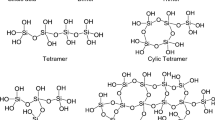Abstract
A wide variety of organo-silicon compounds has been described for application on wood. Some compounds such as organo-functional silanes which are mostly applied in combination with tetraalkoxysilanes (sol-gel process) as well as chlorosilanes and trimethylsilyl derivatives were proposed for a full impregnation treatment of wood. Other systems have been developed for surface treatment of wood such as plasma coating with hexametyldisiloxane and micro-emulsions which mainly contain silane/siloxane mixtures. The effects related to the various treatments vary from an increase in dimensional stability, durability and fire resistance to an enhanced hydrophobation of wood. In the cases of decay and fire resistance a combination of silicon based systems with other chemicals was required to obtain satisfactory results. Due to the excellent water repellent ability and weathering stability of some treatments, application of silicon treated wood under conditions of hazard class III (EN 335 outside above ground exposure) is recommended.



Similar content being viewed by others
Abbreviations
- ASE:
-
anti-shrink efficiency
- ATR-FT-IR:
-
attenuated total reflectance — Fourier transform infrared spectroscopy
- CP MAS-NMR:
-
cross polarisation magic angle spinning nuclear magnetic resonance spectroscopy
- DTA:
-
differential thermal analysis
- DTMOS:
-
decyltrimethoxysilane
- EDX:
-
energy dispersive x-ray analysis
- EETMOS:
-
β-(3,4 epoxycyclohexyl) ethyl trimethoxysilane
- EMC:
-
equilibrium moisture content
- ESCA:
-
electron spectroscopy for chemical analysis
- HFOETMOS:
-
2-heptadecafluorooctylethyltrimethoxysilane
- HMDSO:
-
hexamethyldisiloxane
- IPTEOS:
-
3-isocyanatepropyl triethoxysilane
- MPTMOS:
-
γ-methacryloxypropyl trimethoxysilane
- MTMOS:
-
methyltrimethoxysilane
- PDMS:
-
polydimethylsiloxane
- PTMOS:
-
propyltrimethoxysilane
- TEOS:
-
tetraethoxysilane / triethyl orthosilicate
- TFPTMOS:
-
3,3,3-trifluoropropyltrimethoxysilane
- TGA:
-
thermo-gravimetric analysis
- TMSAH:
-
3-(trimethoxysilyl)propyl (carboxymethyl) decylmethyl ammonium hydroxide inner salt
- TMSCl:
-
trimethylsilyl chloride
- TPT:
-
tetraisopropyl titanate
- VTMOS:
-
vinyl trimethoxysilane
- WPG:
-
weight percent gain
- WRE:
-
water repellent efficiency
References
Anonymous (1989) Silicone. Chemie und Technologie, Vulkan Verlag, Essen
Belyi VA, Kupcinov BI, Savickij VN (1985) Einfluß der Modifizierung von Birkenholz mit siliciumorganischen Verbindungen auf seine Eigenschaften. Holztechnologie 26:247–249
Brebner KI, Schneider MH (1985) Wood-polymer combinations: bonding of alkoxysilane coupling agents to wood. Wood Sci Technol 19:75–81
Cho DL, Sjöblom E (1990) Plasma treatment of wood. J Appl Polym Sci 46:461–472
Denes AR, Tshabalala MA, Rowell R, Denes F, Young RA (1999) Hexamethyldisiloxane-plasma coating of wood surface for creating water repellent characteristics. Holzforschung 53:318–326
Gerhardinger D, Mayer H, Kolleritsch G (1996) Process for impregnating wood. US Patent 5,538,547
Goethals P, Stevens M (1994) Dimensional stability and decay resistance of wood upon modification with some new type chemical reactants. International Research Group on Wood Preservation (IRG/WP 94–40028) Stockholm
Hager R (1995) Waterborne silicones as wood preservatives. International Research Group on Wood Preservation (IRG/WP 95–30062) Stockholm
Lukowsky D, Peek R-D, Rapp AO (1997) Water-based silicones in wood. International Research Group on Wood Preservation (IRG/WP 97–30144) Stockholm
Mahlberg R, Niemi HE-M, Denes F, Rowell RM (1998) Effect of oxygen and hexamethyldisiloxane plasma on morphology, wettability and adhesion properties of polyethylene and lignocellulosics. Int J Adhes Adhes 18:283–297
Mai C, Militz H (2004) Modification of wood with silicon compounds. Inorganic silicon compounds and sol-gel systems. Wood Sci Technol (in press). DOI 10.1007/s00226-003-0205-5
Marquardt H, Schäfer SG (1994) Lehrbuch der Toxikologie. Wissenschaftsverlag, Mannheim, pp 622–623
Miyafuji H, Saka S (2001) Na2O-SiO2 wood inorganic composites prepared by the sol-gel process and their fire resistant properties. J Wood Sci 47:483–489
Ogiso K, Saka S (1994) Wood-inorganic composites prepared by sol-gel processing IV. Effects of chemical bonds between wood and inorganic substances on property enhancement. Mokuzai Gakkaishi 40:1100–1106
Owens CW, Shortle WT, Shigo AL (1980) Silicon tetrachloride: a potential wood preservative. International Research Group on Wood Preservation (IRG/WP 3133) Stockholm
Podgorski L, Bousta C, Schambourg F, Maguin J, Chevet B (2002) Surface modification of wood by plasma polymerisation. Pigm Resin Technol 31:33–40
Saka S, Miyafuji H, Tanno F (2001) Wood-inorganic composites prepared by the sol-gel process. J Sol-Gel Sci Techn 20:213–217
Saka S, Sasaki M, Tanahashi M (1992) Wood-inorganic composites prepared by sol-gel processing I. Wood-inorganic composites with porous structure. Mokuzai Gakkaishi 38:1043–1049
Saka S, Tanno F (1996) Wood-inorganic composites prepared by sol-gel processing VI. Effects of a property-enhancer on fire-resistance in SiO2-P2O5 and SiO2-B2O3 wood-inorganic composites. Mokuzai Gakkaishi 42:81–86
Saka S, Tanno F, Yamamoto A, Tanaka M, Higuchi K (1999) Method for preparing antibacterial/antifungal inorganic matter-composited wood. US Patent 5,985,372
Saka S, Ueno T (1997) Several SiO2 wood-inorganic composites and their fire-resisting properties. Wood Sci Technol 31:457–466
Saka S, Yakake Y (1993) Wood-inorganic composites prepared by sol-gel process III. Chemically-modified wood-inorganic composites. Mokuzai Gakkaishi 75:308–314
Schneider MH, Brebner KL (1985) Wood-polymer combinations: the chemical modification of wood by alkoxysilane coupling agents. Wood Sci Technol 19:67–73
Sèbe G, Brook MA (2001) Hydrophobization of wood surfaces: covalent grafting of silicone polymers. Wood Sci Technol 35:269–282
Sèbe G, De Jéso B (2000) The dimensional stabilisation of maritime pine sapwood (Pinus pinaster) by chemical reaction with organosilicon compounds. Holzforschung 54:474–480
Stevens M (1981) Preliminary results of the treatment of wood with chlorosilanes. International Research Group on Wood Preservation (IRG/WP 3172) Stockholm
Stevens M (1985) Restriction on the use of chlorosilanes as potential wood preservatives. International Research Group on Wood Preservation (IRG/WP 3345) Stockholm
Tanno F, Saka S, Yamamoto A, Takabe K (1998) Antimicrobial TMSAH-added wood-inorganic composites prepared by the sol-gel process. Holzforschung 52:365–370
Zollfrank C (2001) Silylation of solid beech wood. Wood Sci Technol 35:183–189
Zollfrank C, Wegener G (2002) FTIR microscopy and ultrastructural investigation of silylated solid wood. Holzforschung 56:39–42
Author information
Authors and Affiliations
Corresponding author
Rights and permissions
About this article
Cite this article
Mai, C., Militz, H. Modification of wood with silicon compounds. Treatment systems based on organic silicon compounds — a review. Wood Sci Technol 37, 453–461 (2004). https://doi.org/10.1007/s00226-004-0225-9
Received:
Published:
Issue Date:
DOI: https://doi.org/10.1007/s00226-004-0225-9




